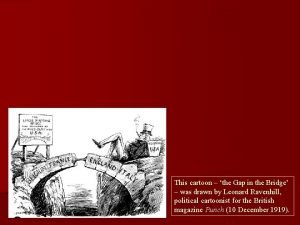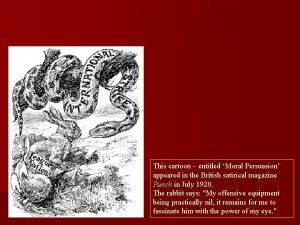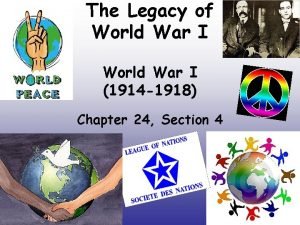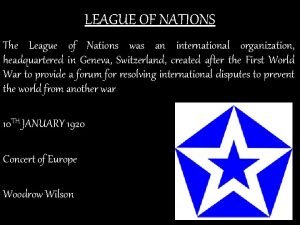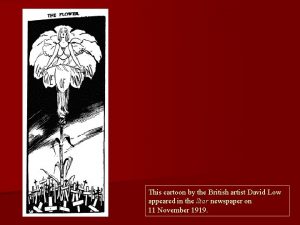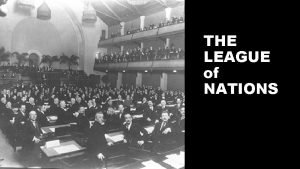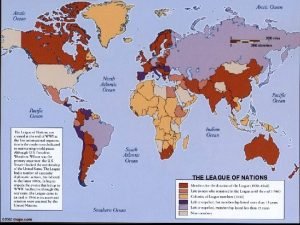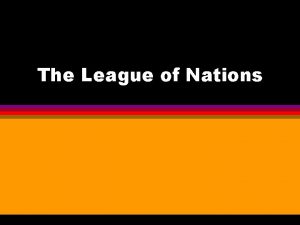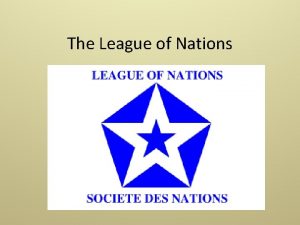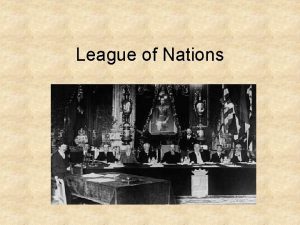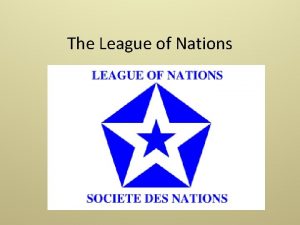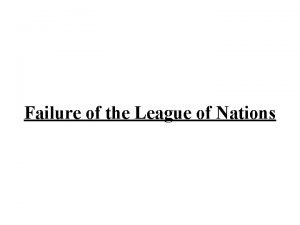THE LEAGUE of NATIONS Why was it set











- Slides: 11

THE LEAGUE of NATIONS

Why was it set up? • Wilson’s liberal vision • Replace “balance of power” politics with “Collective Security” • Basic Principles re: aggression • Outlaw it • Deter it by forming a coalition of non-aggressive states • Punish it collectively

Aid The League of Nations also tried to influence: Health Issues Labour Issues Minorities Mandates Human Rights Collective Security

How was the League organised ? The Assembly Council Met once a year One nation, one vote Decisions had to be unanimous Met regularly to deal with incidents 4 permanent members (Britain, France, Japan, Italy) 4 -11 non permanent members Secretariat Did the paperwork of the League Prepared reports Civil Service Court of International Justice Based in The Hague Settled disputes in international law 15 judges Commissions Mandates Refugees Slavery Health International Labour Organisation

Strengths of the League of Nations • Dealing with social issues such as the improvement of living and working conditions worldwide (through ILO) • Dealing with health issues – targeted the treatment of specific diseases (e. g. leprosy) • Set up commissions that improved living conditions in poorer countries

Weaknesses of the League… • Certain key nations did not join (e. g. USA) – others left (Germany, 1933; Russia joined in 1934, left 1939; Japan left 1932/3; Italy left 1936) • It had no real power to enforce decisions – relied on goodwill and persuasion • No permanent military force • Economic sanctions did not work • Failed to achieve disarmament of all nations in the 1930 s (one of the 4 principal aims of the League) • Decision-making was slow because both Assembly and Council required unanimous votes to take action – sometimes aggressive countries had already been successful before the League got round to action • Certain key members of the Council could veto action (e. g. Italy (19356) and Japan (1931 -2) • Neither Britain nor France gave the League their full support - they were more worried about their own empires and trade, particularly during the World Economic Crisis, 1929 -35

Successes in the 1920 s & • Work of the League’s commissions – particularly refugees, drug trafficking, slavery etc • International Labour Organisation – campaigning for improved working and pay conditions • Border disputes in Upper Silesia in 1921 • Aaland Islands dispute, 1921 • Greek invasion of Bulgaria in 1925 failures • Vilna dispute in 1920 • Greek-Turkish war 1920 -22 • The French and Belgian invasion of the Ruhr in 1923 • The Corfu incident in 1923 • Failure of disarmament efforts in the 1920 s – Washington Naval Treaty (1922), failure to have an international conference on disarmament until 1933 • Failure of self-determination in the Treaties

Successes in the 1920 s & • Supervised peace and disarmament negotiations • 1921 Washington Treaty Conference • 1928 Kellogg-Briand Pact failures


Japan in Manchuria: Watch video and take notes.

Italy in Abyssinia: Watch video and take notes.
 Why did the league of nations fail
Why did the league of nations fail League of nations failure
League of nations failure Total set awareness set consideration set
Total set awareness set consideration set Training set validation set test set
Training set validation set test set Hey hey bye bye
Hey hey bye bye The gap in the bridge political cartoon meaning
The gap in the bridge political cartoon meaning International strife political cartoon
International strife political cartoon Did wilson want to join the league of nations
Did wilson want to join the league of nations League
League League of nations failure
League of nations failure A cartoon that appeared in a british newspaper in 1919
A cartoon that appeared in a british newspaper in 1919 League of nations in hindi
League of nations in hindi





